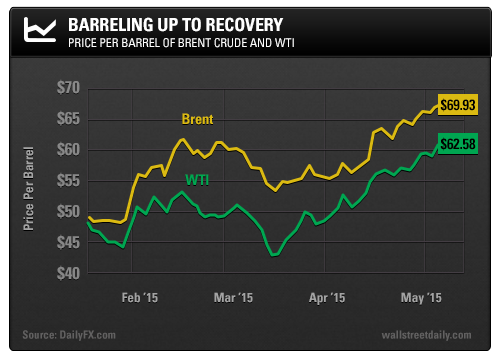Naysayers, doomsday theorists, and sell-in-May advocates are eating their words after forecasts of $20 oil proved to be dead wrong.
Yes, crude oil continues to gallop higher, with prices rising 50% in just over three months.
This week, West Texas Intermediate (WTI) soared above $60 per barrel to $62.58, the highest point so far this year. While Brent Crude went up to $69.93 per barrel.
So how the heck did this happen… and – more importantly – will the momentum continue?
Well, a series of sequential events just happened to fall like a stack of dominos and drove the price of global crude oil up.
You see, U.S. oil production has dropped from its peak and continues to fall. At the same time, rising demand, which has materialized since the collapse of crude oil prices, is allaying a global glut and driving a rebound in crude prices.

Since April’s price rally of between 20% and 25%, oil bulls have been driving the market up on the notion that a supply glut was easing from tightening world production, despite continuous builds in U.S. crude stockpiles.
Meanwhile, the deflation scare has receded as prices have bounced back, with cheap oil helping to spur consumer demand and economic growth.
An unlikely sequence of four events made conditions perfect for this jump.
First Event: The Disruption in Libyan Crude Exports
Protestors seeking state jobs stopped crude flows to the eastern Libyan oil port of Zueitina on Tuesday. Libyan output is already below 500,000 barrels per day (bpd), one-third of what the country pumped prior to 2010.
Zueitina’s closing is particularly harmful to Libya’s oil exports because it was one of only a few Libyan ports still exporting oil. Now, there’s even less oil leaving the country.
Second Event: Saudi Arabia Raised Prices for Northwest Europe
The Saudis increased the official selling prices for its Arab Light grade crude to Northwest Europe to reflect the recent price rally in rival grades.
Saudi Arabian Oil Minister Ali Al-Naimi was quoted by CNBC as saying that no one can set the price of oil, as “it’s up to Allah.” His remark came amid widespread speculation over how long the Organization of the Petroleum Exporting Countries (OPEC) member would stick to its decision not to cut production, a move that could prop up prices further.
Readers can recall that last year’s oil price collapse accelerated after OPEC refused to cut its output limit of 30 million bpd in favor of defending its market share. That shift in policy was driven by Saudi Arabia, the top exporter in the cartel. The country raised its output to a record high, along with other members.
Third Event: A Weak US Dollar
A weaker dollar tends to inflate commodity prices. The dollar is continuing to drift lower in a mixed batch of U.S. economic data, boosting dollar-denominated commodities, including oil.
Fourth Event: The Civil War in Yemen
The civil war in Yemen has kept the oil market on edge, boosting worries about the security of oil supplies in the broader Middle East. Traders fear supply disruptions from the nation’s northern neighbor, Saudi Arabia, or from the other Middle East producers.
America and Europe Fueling the Fire
On top of these four events, favorable activity in the United States and Europe is adding fuel to oil’s upward momentum.
Economic data from both the United States and Europe has been strong, indicative of greater demand for oil. In April, U.S. data showed that services activity rose more than expected. And, the trade deficit soared 43% in March, heightening expectations for tightening, as the Fed is expected to raise U.S. interest rates later this year for the first time since 2006.
Furthermore, the European Commission raised its economic growth forecast for the eurozone to 1.5%, up from a previous forecast of 1.3%.
Weekly inventory data was also bullish for crude.
Oil prices gained again late Tuesday after the American Petroleum Institute (API) data showed a fall of 1.5 million barrels of U.S. crude supply for the week ending on May 1. A Platts survey of analysts had forecasted a climb of 1 million barrels.
Then, on Wednesday, the Energy Information Administration (EIA) reported an inventory fall of 3.9 million barrels.
Both reports further strengthened crude’s price and added credence to the argument that U.S. output is peaking.
But, while the upward trend looks like it’ll continue for crude, investors should not lose sight of the headwinds that’ll prevent crude prices from soaring back to $100 per barrel any time soon.
Nevertheless, the $75 level is quite feasible…
What to Watch For
Some still argue that the market is oversupplied due to OPEC’s pumping almost 2 million bpd above demand. But, OPEC will meet on June 5 in Vienna to discuss production policy.
Some members will likely demand a reduction in the amount of oil being produced so that the price will rise. Yet, even officials from countries who favor a curb know it’s unlikely. Current lower prices are stimulating global demand and putting a brake on more expensive supply sources, such as U.S. shale.
There’s also the prospect of Iranian crude coming back onto the market if sanctions are lifted as part of an international nuclear deal.
If it succeeds in reaching a final deal with Britain, China, France, Russia, Germany, and the United States for its nuclear program, Iran will want other OPEC members to make way for a rise in its exports. The deadline for an agreement is June 30, but it would take time for Iran to raise production.
In fact, the markets receded later this week over concerns that Iranian sanctions may be lifted.
Iran is OPEC’s fifth-largest producer and could produce 4 million bpd in under a year, according to Bloomberg News.
Finally, focus on weekly U.S. inventory statistics. Even as we enter the driving season, producer output may rise due to more favorable prices.
